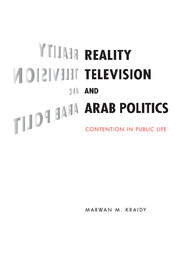Book contents
- Frontmatter
- Contents
- Acknowledgments
- Preface
- Introduction: Beyond al-Jazeera
- 1 Screens of Contention: The Battle for Arab Viewers
- 2 Voting Islam Off the Island? Big Brother in Bahrain
- 3 The Saudi-Lebanese Connection
- 4 Contesting Reality: Star Academy and Islamic Authenticity in Saudi Arabia
- 5 Gendering Reality: Kuwait in the Eye of the Storm
- 6 A Battle of Nations: Superstar and the Lebanon-Syria Media War
- 7 The “New Middle East”? Reality Television and the “Independence Intifada”
- Conclusion: Performing Politics, Taming Modernity
- List of Interviews
- Further Readings
- Bibliography
- Index
- Titles in the Series
7 - The “New Middle East”? Reality Television and the “Independence Intifada”
Published online by Cambridge University Press: 05 June 2012
- Frontmatter
- Contents
- Acknowledgments
- Preface
- Introduction: Beyond al-Jazeera
- 1 Screens of Contention: The Battle for Arab Viewers
- 2 Voting Islam Off the Island? Big Brother in Bahrain
- 3 The Saudi-Lebanese Connection
- 4 Contesting Reality: Star Academy and Islamic Authenticity in Saudi Arabia
- 5 Gendering Reality: Kuwait in the Eye of the Storm
- 6 A Battle of Nations: Superstar and the Lebanon-Syria Media War
- 7 The “New Middle East”? Reality Television and the “Independence Intifada”
- Conclusion: Performing Politics, Taming Modernity
- List of Interviews
- Further Readings
- Bibliography
- Index
- Titles in the Series
Summary
At 12:56:26 p.m., on February 14, 2005, a massive explosion resounded throughout Beirut. At first, many Beirutis assumed from experience that Israeli air-force jets had crossed the sound barrier in a mock raid over the Lebanese capital. Others in the city felt the ground shaking and thought that it was an actual Israeli air bombing. Then people saw black smoke billowing from the seaside road alongside the famous St. George Hotel, a prewar hangout for socialites, spies, and intellectuals. Minutes earlier, Rafiq al-Hariri, Lebanon's erstwhile prime minister and a towering personality in postwar Lebanese politics, had left the Lebanese Parliament building located at Place de l'Étoile, driving his own car wedged within his security convoy to his mansion in the Quraytem neighborhood of Beirut. Out of three possible itineraries, Hariri's security detail selected the route that was likely to have the least traffic at that hour of the day, which passed by the St. George. As it rode past the hotel, a white Mitsubishi van cut through the convoy and exploded, killing al-Hariri and twenty one others.
Al-Hariri had spent the morning participating in legislative debate over a controversial electoral law that was engineered by Syrian military intelligence to favor pro-Syrian candidates in the 2000 elections. Discussions of the law were heating up ahead of the 2005 parliamentary elections on which Hariri pinned his hopes to regain the prime minister's seat.
- Type
- Chapter
- Information
- Reality Television and Arab PoliticsContention in Public Life, pp. 166 - 191Publisher: Cambridge University PressPrint publication year: 2009



